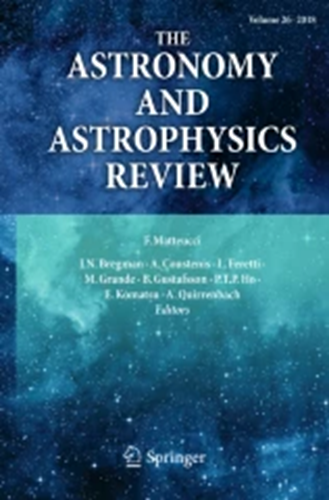之前发生了什么?
IF 26.5
1区 物理与天体物理
Q1 ASTRONOMY & ASTROPHYSICS
引用次数: 9
摘要
我们试图在距离太阳500pc的太阳附近找到赫比格Ae/Be恒星的前体。为此,我们创建了一个光学选择的中等质量t -金牛座恒星(IMTT恒星)样本,这里定义为质量$1.5 M_{\odot}\leq M_* \leq 5 M_{\odot}$,光谱类型在F和K3之间的恒星,来自文献。我们使用文献光学光度测定法(0.4-1.25 $\mu$ m)和由Gaia DR2视差测量确定的距离以及Kurucz恒星模型光谱将恒星放置在hr图中。根据西斯的进化轨迹,我们从文献中确定了中等质量的金牛座恒星,并得出了质量和年龄。我们利用斯皮策光谱根据它们的[F $_{30}$ /F $_{13.5}$]光谱指数将恒星周围的盘划分为Meeus I族和Meeus II族。我们还研究了10 $\mu$ m硅酸盐粉尘颗粒的排放,并确定了多环芳烃(PAH)的排放。由此,我们建立了中间质量的金牛座t星周围的圆盘的定性图像,并将其与可用的红外和亚毫米波长的空间分辨率图像进行比较,以确认我们的分类。我们发现49颗中等质量的金牛座t型恒星有红外过剩。已识别的圆盘在圆盘几何形状和硅酸盐尘埃颗粒数量上与赫比格Ae/Be星相似。红外线和亚毫米波长的空间分辨图像表明,在赫比格Ae/Be恒星的年轻前体周围也存在间隙和螺旋。将恒星演化的时间尺度与当前的原行星盘演化模型进行比较,发现赫比格Ae/Be恒星与中等质量金牛座t星之间的相似性表明,I群和II群盘的演化是分离的,它们代表了两条不同的演化路径。本文章由计算机程序翻译,如有差异,请以英文原文为准。
What happened before?
We seek to find the precursors of the Herbig Ae/Be stars in the solar vicinity within 500 pc from the Sun. We do this by creating an optically selected sample of intermediate mass T-Tauri stars (IMTT stars) here defined as stars of masses $1.5 M_{\odot}\leq M_* \leq 5 M_{\odot}$ and spectral type between F and K3, from literature. We use literature optical photometry (0.4-1.25$\mu$m) and distances determined from Gaia DR2 parallax measurements together with Kurucz stellar model spectra to place the stars in a HR-diagram. With Siess evolutionary tracks we identify intermediate mass T-Tauri stars from literature and derive masses and ages. We use Spitzer spectra to classify the disks around the stars into Meeus Group I and Group II disks based on their [F$_{30}$/F$_{13.5}$] spectral index. We also examine the 10$\mu$m silicate dust grain emission and identify emission from Polycyclic Aromatic Hydrocarbons (PAH). From this we build a qualitative picture of the disks around the intermediate mass T-Tauri stars and compare this with available spatially resolved images at infrared and at sub-millimeter wavelengths to confirm our classification. We find 49 intermediate mass T-Tauri stars with infrared excess. The identified disks are similar to the older Herbig Ae/Be stars in disk geometries and silicate dust grain population. Spatially resolved images at infra-red and sub-mm wavelengths suggest gaps and spirals are also present around the younger precursors to the Herbig Ae/Be stars. Comparing the timescale of stellar evolution towards the main sequence and current models of protoplanetary disk evolution the similarity between Herbig Ae/Be stars and the intermediate mass T-Tauri stars points towards an evolution of Group I and Group II disks that are disconnected, and that they represent two different evolutionary paths.
求助全文
通过发布文献求助,成功后即可免费获取论文全文。
去求助
来源期刊

The Astronomy and Astrophysics Review
地学天文-天文与天体物理
CiteScore
45.00
自引率
0.80%
发文量
7
期刊介绍:
The Astronomy and Astrophysics Review is a journal that covers all areas of astronomy and astrophysics. It includes subjects related to other fields such as laboratory or particle physics, cosmic ray physics, studies in the solar system, astrobiology, instrumentation, and computational and statistical methods with specific astronomical applications. The frequency of review articles depends on the level of activity in different areas. The journal focuses on publishing review articles that are scientifically rigorous and easily comprehensible. These articles serve as a valuable resource for scientists, students, researchers, and lecturers who want to explore new or unfamiliar fields. The journal is abstracted and indexed in various databases including the Astrophysics Data System (ADS), BFI List, CNKI, CNPIEC, Current Contents/Physical, Chemical and Earth Sciences, Dimensions, EBSCO Academic Search, EI Compendex, Japanese Science and Technology, and more.
 求助内容:
求助内容: 应助结果提醒方式:
应助结果提醒方式:


